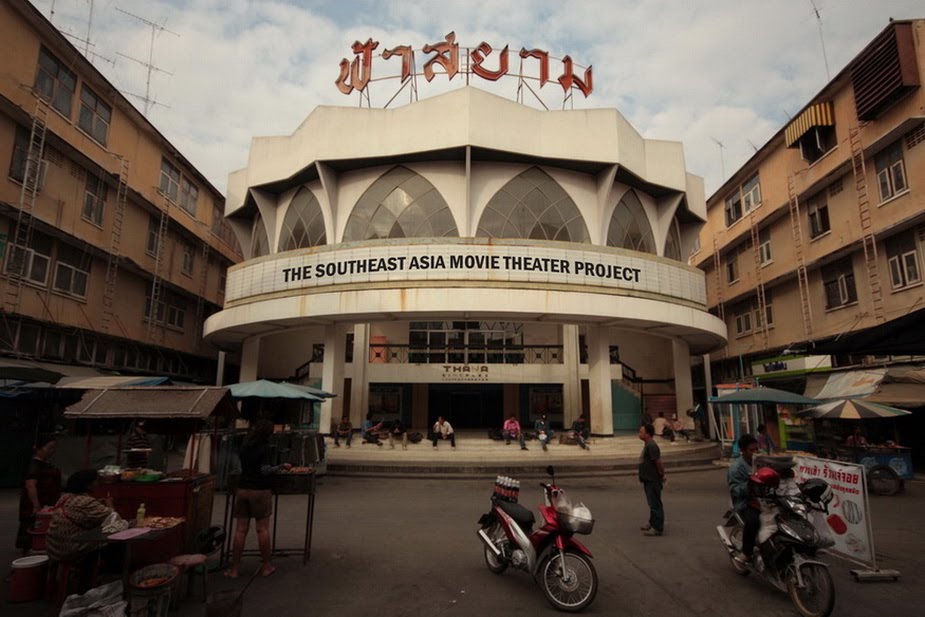But there's an atypical corollary to the dwindling number of theaters. As a sizable portion of older theaters across Myanmar go out of business, an opposing trend towards renovation and technical upgrades is being seen in select cases (including one of the two remaining theaters in the aforementioned Irrawaddy Region). Economic confidence, sparked by the relaxing of some trade embargoes in the wake of political reforms has, it would seem, trickled down to the film industry. As the Ministry of Information privatizes its stock of old theaters, some of them have been acquired by cinema-minded entrepreneurs.
Though still by far the exception, this slowly expanding phenomenon represents a bright spot for preservationists, while offering a glimmer of hope that a human-focused, anti-sprawl form of development will find some adherents in Myanmar. Aside from Yangon and Mandalay, the numbers one and two largest cities, Myanmar's many towns and cities tend to be compact and centralized, with work place and residence often in the same location. This pre-suburban sprawl living arrangement is the reason why so many of Myanmar's old theaters have managed to survive in the first place.
To put that in context, cities across the developed world are pursuing policies that aim to curb sprawl and revive historic town cores. In that sense, Myanmar's long stagnation has left it in an advantageous position if it takes strides to limit private car ownership, enhance public transit and preserve its historic urban cores. Stand-alone movie theaters - the cultural anchors of modern urbanity - can play a major role in keeping the downtown core vibrant.
That said, Lashio in upper Shan State has the distinction of being home to two recently renovated stand-alone movie theaters. The first of the two was highlighted here a few months ago. The second and more recent upgrade is the Aung Thiri Cinema.
The commercial core of Lashio is built on the side of a hill, giving the town a naturally textured siting. Its topographical charm is further complemented by a medley of buildings from different eras, some made of wood, some brick and plaster, some concrete. Space in front of the buildings, from the sidewalks and to the edge of streets are the preserve of hawkers, peddling wares from fresh fruit to cheap electronics. Pedestrians are more or less confined to the streets themselves, reflecting what is at best an early motorized society. In other words, the strict delineation of space has yet to be hashed out.
At the center of this city organism, hidden from plain sight behind a wall of concrete retail stalls, is the Aung Thiri Cinema. To reach the theater, one must go through a passage way between the little stalls which opens onto a plaza surrounding the theater.
The architecture of the Aung Thiri is simple. The main structure is brick and concrete, though some interior parts are made of wood. Semi-circle arches sit atop concrete pilasters stacked vertically in the lengthwise procession of the facade. A very common orientation for Myanmar movie theaters. Logical in some ways, as it makes entering and exiting less of a bottle neck.
There is no real lobby area to speak of, just a row of benches within a veranda. Folding wooden doors lead directly into the 400 seat auditorium.
New dimensional signage on the roof advertises the Aung Thiri Cinema and its recently installed 3D projection system
Poster examination in the theater's veranda
Concessionaires
Evidence that the charms of the old can live harmoniously with the efficiency and sophistication of the new: the Aung Thiri's original wrought iron ticket window is looking as good as ever, while the ticketing system has been upgraded to a computer system.
Upgraded seating, sound proofing and new lighting have been installed, ushering the Aung Thiri into the contemporary age.
A theater from 1960's Burma looking much like a contemporary multiplex anywhere in the world.
Revitalization of the Aung Thiri Cinema comes at the behest of Yangon-based Mingalar Cinemas, Myanmar's largest theater chain and a proactive player in the preservation of old stand-alones. In 2014, Mingalar partnered with local operators to bring new life the Aung Thiri, which had been dormant since 2003.
Seating was modernized, replacing the theater's original teak wood bench seats with the contemporary cushioned and folding kind. An air-conditioning system was installed for the first time. A brand new screen. But above all else, a digital projector replaced the antiquated if still functional carbon-arc projectors, allowing for the latest in international productions to be screened in top notch quality.
For Lashio, a town once at the far end of accessibility in a country that had long been blocked from the goings-on of the wider world, movie-going is officially in the 21st century. Accompanied, no less, by a treasured piece of the town's social history.
The Aung Thiri at night.
Photography and research at the Aung Thiri Cinema was made possible by the man in the photo below, Mr. Sai Ni Yon, whose impeccable English and generous nature made an often challenging task a breeze. Not only was I granted full access to the Aung Thiri, but he very kindly imparted the historic details of this recently resuscitated cinema treasure.






























